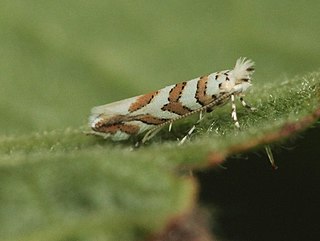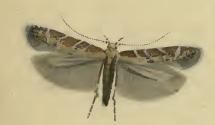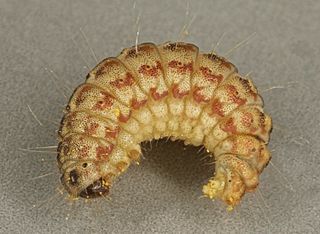
Lobesia littoralis is a moth of the family Tortricidae. It is distributed wherever the foodplant occurs around the coasts of Europe, including the Faroes, Iceland and St Kilda.

Parapoynx fluctuosalis or Fluctuating China-mark or Waved China-mark, is a moth of the family Crambidae. It is a widespread species, known from Africa, India, Sri Lanka, China, Japan, Malaysia, Taiwan, Guam, Hawaii, Fiji, Australia and the Galápagos Islands. It is also an introduced species in Europe, where it has been recorded from Great Britain, the Iberian Peninsula and Sardinia.

Phyllonorycter kuhlweiniella is a moth of the family Gracillariidae. It is found from Germany to the Iberian Peninsula, Italy and Albania and from Great Britain to central and southern Russia.

Aspilapteryx tringipennella is a moth of the family Gracillariidae. It is known from all of Europe.

Evergestis frumentalis is a moth of the family Crambidae. It is found from the Iberian Peninsula through southern and central Europe and southern Fennoscandia to central Asia and southern Siberia. The species was first described by Carl Linnaeus in 1761.

Pediasia trisecta, the large sod webworm or greater sod webworm, is a moth of the family Crambidae. It is found in the United States and southern Canada.

Scotopteryx bipunctaria, also known as the chalk carpet, is a moth in the family Geometridae. The species was first described by Michael Denis and Ignaz Schiffermüller in 1775. It is found from Morocco and Spain through western and central Europe and Great Britain to the Ural. In the north it is found up to the Baltic region and in the south its range extends over Italy and the Balkan Peninsula up to the Black Sea and Caspian Sea.

Narraga tessularia is a moth of the family Geometridae. It is found in Slovakia, Austria, Hungary, Romania, Bulgaria and Russia.

Aristotelia brizella is a moth of the family Gelechiidae. It is found in most of Europe, except Ireland, Switzerland and most of the Balkan Peninsula. Outside of Europe, it is found in North Africa and the Near East.

Bucculatrix demaryella is a moth of the family Bucculatricidae. The species was first described by Philogène Auguste Joseph Duponchel in 1840. It is found in most of Europe, Russia and Japan.
Fundella pellucens, the Caribbean pod borer, is a species of snout moth in the genus Fundella. It was described by Zeller in 1848.

Delplanqueia dilutella is a species of moth in the family Pyralidae. It was described by Michael Denis and Ignaz Schiffermüller in 1775. It is found in most of Europe, east to Russia, Turkey, Iran and Mongolia.

Phycitodes is a genus of snout moths described by George Hampson in 1917.

Phycitodes albatella is a species of snout moth. It is found in most of Europe, Uzbekistan and North America.

Phycitodes binaevella is a species of snout moth described by Jacob Hübner in 1813. It is found in most of Europe, Asia Minor, Lebanon and the Palestinian Territories.
Phycitodes inquinatella is a species of snout moth. It is found in most of Europe, the Canary Islands, Turkey and the Palestinian Territories.

Phycitodes lacteella is a species of snout moth first described by Walter Rothschild in 1915. It is found in most of Europe, Algeria, Morocco and Turkey.

Phycitodes saxicola, the small clouded knot-horn, is a species of snout moth described by Vaughan in 1870. It is found in most of Europe, as well as Iran, Morocco and the Canary Islands.

Phycitodes subcretacella is a species of snout moth. It was described from Japan, but is also found in Spain and Russia.
Elophila occidentalis is a moth in the family Crambidae. It was described by William Harry Lange in 1956. It is found in the United States, where it has been recorded from California, Arizona and Nebraska.















